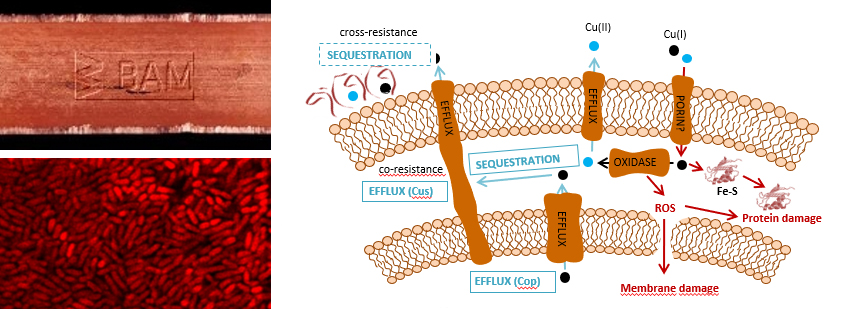
Copper, an antimicrobial material. Antibiotic-resistant bacteria. Mechanisms of cross-resistance of copper and antibiotics.
Source: BAM, division Biodeterioration and Reference Organisms
Antibiotic-resistant, pathogenic bacteria are harmful to humans and must be kept in check within hospitals. Antimicrobial surfaces are a widely discussed and already applied strategy that aims to kill bacteria upon contact to such materials. However, certain resistance mechanisms that allow bacteria to survive on antimicrobial surfaces make them also resistant to antibiotics. This phenomenon is termed cross-resistance.
Therefore, it is unclear, whether the benefit of antimicrobial surfaces outweighs the risk for enrichment of antibiotic-resistant bacteria. Now, BAM researchers, together with colleagues from Finland, England, Denmark and Estonia, released a review article that summarizes the knowledge and knowledge gaps related to the use of antimicrobial surfaces and resistance in hospitals.
The article describes the manifold observations that were made in connection with cross-resistances between antibiotics and materials used for antimicrobials surfaces, such as silver and copper. However, the knowledge gaps are large. Many of the described mechanisms have not been examined under conditions relevant in hospitals. Moreover, efficacy testing for surfaces are done under liquid conditions, which compare poorly to the dry milieu in hospitals. In turn, most studies that investigated the benefits of antimicrobial surfaces under real-life conditions in hospitals could not show a clear reduction of hospital-acquired infections. Furthermore, studies are missing that examine, whether the use of antimicrobial surfaces in hospitals leads to an enrichment of antibiotic-resistant bacteria under real-life conditions.
Taken together, it is still a long way to go for researchers before antimicrobial surfaces can be used safely in hospitals. Risk assessment of antimicrobial surfaces is not only important for hospitals. Such materials are increasingly used in households, for example in fridges, cutting boards and textiles.
Selection of resistance by antimicrobial coatings in the healthcare setting
Franziska Pietsch, A. J. O'Neill, A. Ivask, H. Jenssen, J. Inkinen, A. Kahru, M. Ahonen, Frank Schreiber
published in Journal of Hospital Infection, Vol. 106, issue 1, pages 115 -125
BAM Division Biodeterioration and Reference Organisms


